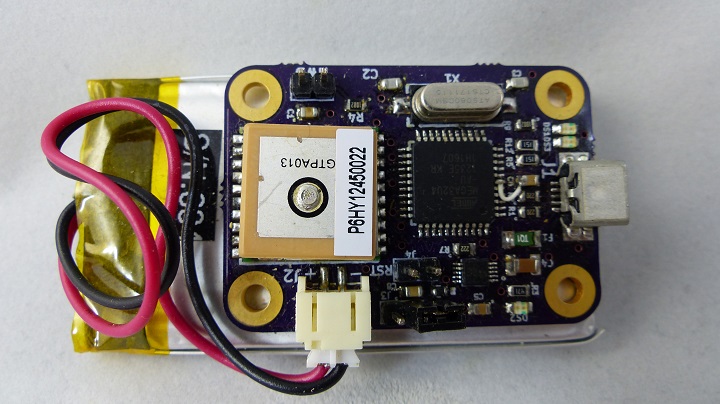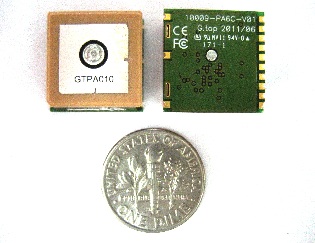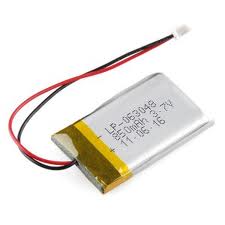USB-GPS
Jump to navigation
Jump to search
Contents
USB-GPS Features
Minimal design No battery draining display Indicators 2 Programmable LEDs For instance, LED can be programmed to reflect the GPS lock signal Can be programmed to not go on for "stealth" applications Charge in progress (red)/charge complete (green) LED MT3339 GPS - Capable of Data logging up to 16 hours at 32 seconds per log entry ATMega32U4, 8-bit Microprocessor Built-in USB interface Doesn't require FTDI friend or other USB to TTL interface Mini-USB-B jack Information about USB connectors Used for battery charging and Host Communication Li-Polymer battery charger Charges from USB JST connector for direct battery connection Compatible with Li-Poly Batteries Extended voltage operation from 4.2V down to 3.0V of Li-Poly batteries Works with Adafruit 1300 mA-hr Li-Poly battery Battery form factor of battery is 1.35" x 2.55" x 0.23" Works with Sparkfun 850 mA-hr battery Form factor of 1.16" x 1.9" x 0.23" Measured 35 mA current draw Allows for 36+ hr battery life with 1300 ma-hr battery or 24+ hours with the 850 ma-hr battery Well beyond the 32 hour log time of the GPS (in 15 second mode) Battery life could be extended while logging by putting the AVR into sleep mode (20-25 mA for GPS only) Very Small form factor 1.79x1.27 inch Design goal was to make the device and battery small enough to fit into an Tic Tac candy dispenser
Connectors
J1 - USB, Mini-B
Standard USB Mini-B pinout.
J2 - JST connector for Li-Poly battery
J3 - Power Switch
The power switch has a two pin header. When the pins are connected the power is applied from the battery to the rest of the card.
J4 - Reset
Reset has a two pin header. To reset the Microprocessor temporarily short the two pins. To enter programming mode, the HWB jumper should be installed prior to activating the reset.
J5 - HWB
HWB is used for programming the Microprocessor.
Pin Description 1 HWB (pulled up tp +5V) 2 Ground Install shunt from 1-2 to allow board to go into programming mode (also requires cycling the reset line to the Microprocessor.
SW1 - Input switch for control
Indicators
Indicator Function DS2 On = USB power is good DS1 Microprocessor PB2 output pin DS3 Microprocessor PB1 output pin
Part Selection
GPS selection - MTK3339
Low Cost ($30) MTK3339 GPS part from Adafruit -165 dBm sensitivity, 10 Hz updates, 66 channels Ultra low power usage: 20mA current draw while tracking, 25mA acquisition Power Supply, VCC: 3.0V to 4.3V, (VBACKUP: 2.0V to 4.3V not used) RTC battery-compatible (LiPoly battery connects to this) Built-in "LOCUS" datalogging (up to 16 hours) PPS output on fix Tested at 27 Km altitude Internal patch antenna + connection for optional external active antenna Fix status output Ultra small size: only 16mm x 16mm x 5mm and 4 grams Frequency L1, 1575.42MHz Sensitivity1 Acquisition: -148dBm, cold start, Reacquisition: -163dBm, Hot start Tracking: -165dBm Channel 66 channels TTFF Hot start: 1 second typical, Warm start: 33 seconds typical, Cold start: 35 seconds typical (No. of SVs>4, C/N>40dB, PDop<1.5) Without aid:3.0m (50% CEP) DGPS (SBAS(WAAS,EGNOS,MSAS)):2.5m (50% CEP) Position Accuracy Velocity Accuracy Without aid : 0.1m/s DGPS (SBAS(WAAS,EGNOS,MSAS,GAGAN)):0.05m/s Without aid:0.1 m/s2 Acceleration Accuracy Without aid:0.1 m/ DGPS (SBAS(WAAS,EGNOS,MSAS)):0.05m/s2 Timing Accuracy 10 ns RMS (1PPS Output) Altitude Maximum 18,000m (60,000 feet) Velocity Maximum 515m/s (1000 knots) Acceleration Maximum 4G Update Rate 1Hz (default), maximum 10Hz Baud Rate 9600 bps (default) DGPS SBAS (defult) [QZSS,WAAS, EGNOS, MSAS,GAGAN] AGPS Support Working Temperature -40 °C to +85 °C Dimension 16 x 16 x 6.2mm, SMD Weight 6g
Battery Selection - 3.7V Li-Poly
Rechargeable - Many choices of mA-hr capacities Slow self discharge rate - LiPo best fit GPS stores up to 16 hours of breadcrumbs. GPS uses 20 mA when in sync Arduino can go into sleep mode using 0 mA 16 hrs x 22 mA / hr = 32; 0 mAh ID AdaFruit part - : 258 has features: Cost $10 Weight: 25g Size: 1.35" x 2.55" x 0.23" (35mm x 65mm x 5.5mm) Size means part won't fit into a small Altoids' tin. Output: 1300mAh at 3.7V nominal 1300 mAhr / 20 mA = 65 hrs (2+ days) Sparkfun part has features: Cost $9 860 mAhr 1.16" x 1.9" x 0.23"
Charger Selection - MCP73833
Charges Lithium Polymer batteries from USB power (+5V at 500 mA) Charges in < 3 hrs
Enclosures - Candy
Drivers/Software
KML output for use with Google Earth Arduino development environment compatible GPS data logger application USB GPS Software repository LUFA Serial USB to Serial working] Adafruit driver for MTK3339 GPS datalogger
Revision X2 Improvements over the X1 board
NTC resistor pads 0603 to match available parts (X1 had 0805 pads) Added reset header holes to make firmware development easier Moved resistor near JST power connector to make it easier to move JST in Move around parts near LiPoly charger to make more room Eliminated the connections from the LiPoly charger to the Microprocessor so to eliminate backpowering the charger from the Microprocessor Changed the LED associated with the charger from indicating that there is +5V to the PG (power good) output of the charger Battery connected directly to the GPS VBATT power connection to keep the GPS in low-power mode when shut off
Revision X1 Board
File:Usb-gps-x1 scan scaled.png
Connectors (Rev X1)
J1 - USB, Mini-B Standard USB Mini-B pinout. J2 - JST connector for Li-Poly battery Standard JST connector mates to the JST connector at the end of the battery wires. J3 - Power Switch The power switch has a two pin header. When the pins are connected the power is applied from the battery to the rest of the card. SJ1 - HWB
Revision X1 - Issues
- Vbackup on GPS should connect directly to VBATT so that when the power switch is off, the GPS still retains the settings
( GPS Rev X1 Hardware Bring-up Notes


